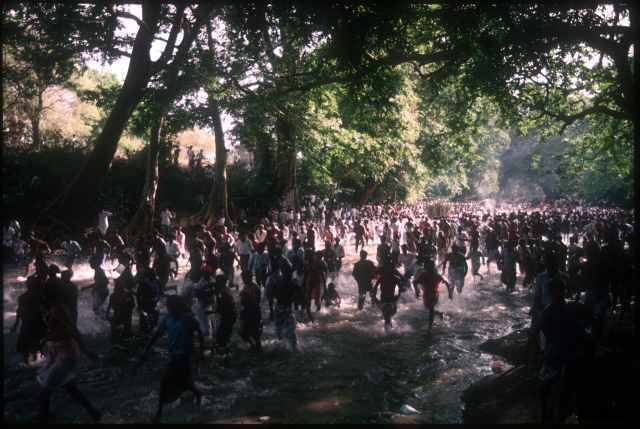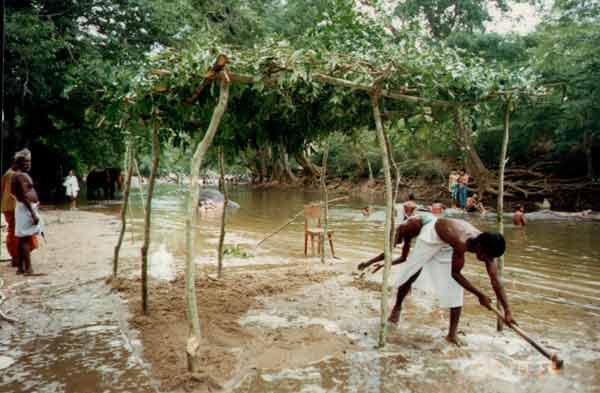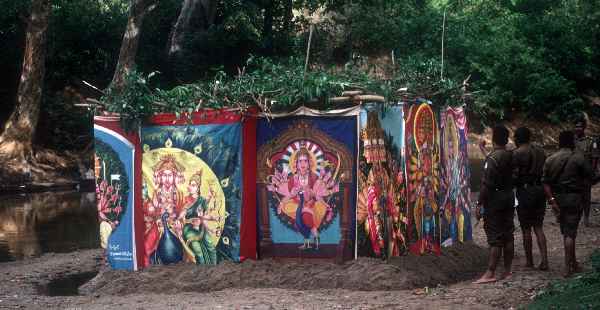The Water-cutting Ceremony or Diya-kaepima

|
"all along the river, men and women are splashing in the water, many lying prostate in it, whilst most of them make sure that they obtain a vessel full of this sacred water to take home with them." |
Sri Lankans believe that the water collected at the diya kaepima
(water-cutting) ceremony is sacred and to touch this water or to bathe in it is
considered particularly efficacious to remove evil. Therefore people collect at
a spot just below the site of water-cutting to allow the sacralized water to
touch their half-naked bodies already immersed in water.
This is especially true of the water cutting ceremonies at Kataragama. The water-cutting
ceremony at the Menik Ganga is particularly interesting because it is shared
both by the Buddhists and the Hindus.
Cartman, in his Hinduism in Ceylon (7.122-123) describes this water-cutting
festival that takes place in the early hours of the morning, thus:
"But the most spectacular procession is on the last night of the festival when the
object of worship, placed upon the sacred elephant, is taken not only to the
Valli Amman Temple but also to the Kiri Vihare. The following morning the high
priest again accompanies the sacred elephant in procession.
They proceed from the Skanda Temple, call at the Valli Amman Temple and then descend
to the Menik River where the water-cutting ceremony takes place. A tent-like
construction is placed in the river at a chosen point. It is covered with
leaves and branches. The high priest alone enters this enclosure. Here he
stays, sometimes two to three hours, awaiting the auspicious moment.
Meanwhile the crowd gathers round, standing in the shallow water, or sitting on the banks
on either side of the river. Men from various walks of life, all stand together
bare-bodied. Meanwhile the sacred elephant stands sentry outside the tent...
When the auspicious moment arrives, the high priest leaves the tent, and
together with the elephant, moves quickly away from the scene."

|
Construction of the water-cutting pandal the day before the ceremony |

|
The pandal beside the Menik Ganga for the diya kaepima or water-cutting |
"But immediately he emerges from the tent, there is a great shout from the people,
and the tent is crushed down by those who seek to reach this most sacred spot.
There they bathe in, and drink of, the water. Elsewhere all along the river,
men and women are splashing in the water, many lying prostate in it, whilst
most of them make sure that they obtain a vessel full of this sacred water to
take home with them."
Gombrich and Obeysekere (Buddhism Transformed, 1990, p. 166) see the water-cutting ceremony held at Kataragama ass a form of water-sports (diya-keliya):
"The fortnight's pageant culminates with the ritual of water-cutting, which ordinary people believe commemorates the washing of the deity's clothes, polluted
by sexual intercourse. (Originally the rite was intended to control the element of water in the environment). After the water-cutting the assembled throng let themselves go.
They sport in the water (diya keliya) and splash themselves and each other, and there is a cathartic and exuberant display of emotion. The pageant
celebrates the god's passion and sensuality, it is a glorification of the life of the senses."
From Water in Culture: The Sri Lankan Heritage by J.B. Disanayaka (Colombo:
Ministry of Environment & Parliamentary Affairs, 1992), pp. 32-33 and 105-106.
